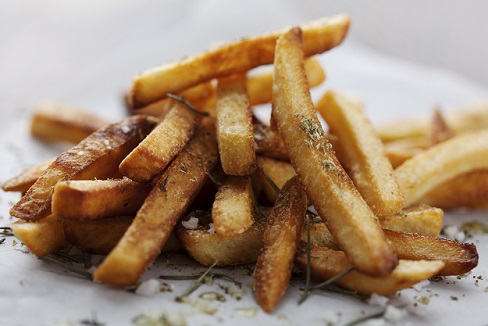 In the nutritional sphere, the war between various types of fat has raged on for decades.
In the nutritional sphere, the war between various types of fat has raged on for decades.
The saturated fat lovers argue that polyunsaturated fats (vegetable oils, fish oil) can and will lead to cancer, and that we should all be feasting on animal fat and butter. There’s new evidence to suggest that common vegetable oils like sunflower oil and canola oil cause acne.
Meanwhile, proponents of polyunsaturated fats argue that saturated fats in butter and meat will lead to heart disease and diabetes, and that vegetable oils are what we should be eating.
There’s no hope of the two sides reaching agreement any time soon. However there’s one fat that everyone agrees is unhealthy: the notorious trans-fat.
Trans-fats are vilified by such a wide and overwhelming set of evidence that nobody in their right mind would defend them. Trans-fats have been linked to inflammation, they have been linked to impaired nutrient absorption, they have been linked to cancer and diabetes.
Agreement on a subject is almost unheard of in the nutritional world, but nobody denies that trans-fats are evil. Governments all over the world are now considering a ban before it’s too late. The US government is notoriously reluctant to ban widely-used food ingredients, but now even they cannot sit idly by.
To put it bluntly, eating trans-fats on a regular basis is a sure-fire method to completely destroy your health…
…and importantly for us, trans-fats are also a huge cause of acne.
What are trans-fats?
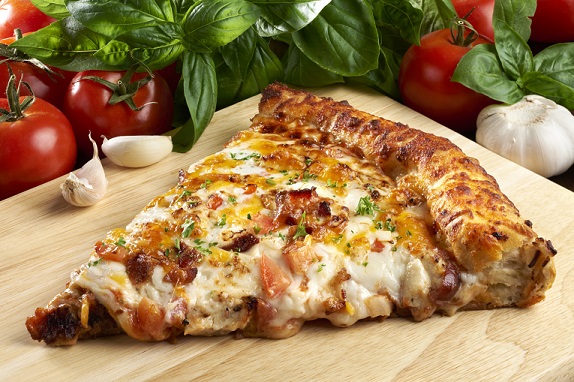 A trans-fat is at its most basic, a chemically altered “mutant” fat. It is a type of fat that was once natural, but has had its molecular structure altered so that it can be solid at room temperature.
A trans-fat is at its most basic, a chemically altered “mutant” fat. It is a type of fat that was once natural, but has had its molecular structure altered so that it can be solid at room temperature.
First you need to understand the specific types of fat: firstly, you have saturated fats, the type predominantly found in dairy products and animal fat. Saturated fats are called saturated because their chemical structure is filled with hydrogen atoms. There are no double bonds in the molecule and that makes saturated fat very stable.
Next you have monounsaturated fats, which have one chemical bond that is hydrogen free, hence the term “mono” (one) unsaturated. These are less stable than saturated fats but still fairly stable. Sources include macadamia nuts, avocados, and olive oil.
Finally you have polyunsaturated fats, which have numerous double bonds without hydrogen atoms. This makes them far more unstable than both saturated fats and monounsaturated fats. The result is that polyunsaturated fats have a low melting point. That’s why all the vegetable oils lining the shelves are liquid and that’s why they never solidify.
Read Annihilate Your Acne – learn how to clear your skin permanently
One of the most important differences between the various fats is that polyunsaturated fats happen to be a lot cheaper to produce. Not because of any chemical characteristics; it just happens that vegetable oils require less resources to produce compared to butter or animal fats.
This created a tricky dilemma for food producers in the early 1900s, who wanted to use a solid fat in products like chocolate or cake. Their preference was to use saturated fats but that would drive up costs and push down profits. Polyunsaturated fats were a no-go due to being liquid. Cake and donut companies had simply run out of fats…
…and therefore their glorious solution was to hire a bunch of scientists to engineer a new one altogether: the trans-fat. About 100 years ago scientists perfected the process of hydrogenation. This is a factory process that takes a fat, probably a cheap polyunsaturated one, and forces an extra hydrogen atom into it. This alters the fat’s molecular structure, changing its melting point and allowing it to be solid at room temperature.
What is the name of this new-fangled fat? Trans-fat is the name. They are basically fats that were once natural but have been chemically altered, for cost-cutting or food quality purposes, to create a fat that is not found in nature.
Food producers love trans-fats because they both create the perfect texture, and they keep costs very low. Trans-fats can lurk in any processed food that contains solid fats; this includes donuts, biscuits, cakes, cookies, pizza, and countless others. Trans-fats are great for butter alternatives like margarine; hydrogenation can make vegetables oils solid and easy to spread on toast or whatever else.
Why trans-fats are pure evil
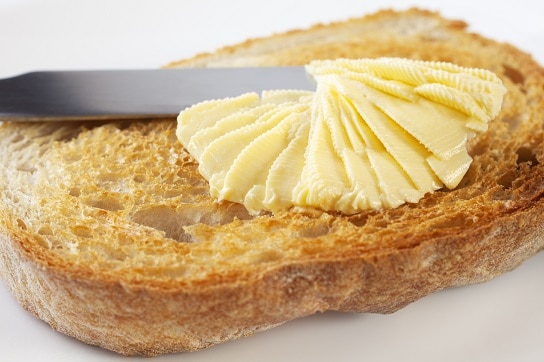 The problem with trans-fats is that their molecular structure is not found anywhere in nature. No human ate trans-fats before 120 years ago; we’ve only been eating them for the equivalent of a few seconds on the clock of humanity’s total existence.
The problem with trans-fats is that their molecular structure is not found anywhere in nature. No human ate trans-fats before 120 years ago; we’ve only been eating them for the equivalent of a few seconds on the clock of humanity’s total existence.
We are simply not adapted to handle them, and numerous health problems occur when our bodies attempt to. Countless studies show that trans-fats lead to heart disease. This study found that replacing other saturated, monounsaturated or polyunsaturated fat with trans-fat led to a dramatic worsening of the ratio between LDL cholesterol (bad) and HDL cholesterol (good). It’s this ratio between cholesterol that’s most important for the development of cardiovascular disease, rather than simply total cholesterol levels.
This study found similar results, as have countless others. In fact, the big increase in heart disease over the 20th century correlated very well with the introduction of trans-fats; those events both began roughly 110 years ago. There’s also emerging evidence that trans-fats lead to cancer and diabetes. Trans-fats are a nightmare for your health in nearly every way.
Trans-fats cause acne because they trigger a big inflammatory response, and thus eating plenty will cause this inflammation to become chronic. Chronic inflammation is the second big cause behind acne. It is when a ramped up immune system pumps out too many inflammatory chemicals, causing your spots to redden and swell up. The effect of trans-fats on inflammation is extremely well documented and is second only to its effect on heart disease:
- This study fed patients either margarine (high in trans-fat), soybean oil (mostly polyunsaturated fat), or butter (mostly saturated fat), on a diet where fat accounted for 30% of total calories (about average). After 32 days, the margarine group had by far the highest levels of inflammatory chemicals circulating their bloodstream. Their levels of interleukin-6 and TNF-a, two of the most abundant inflammatory cytokines, had increased significantly. Meanwhile, the other two groups noticed little difference.
- This study found that a diet rich in trans-fats significantly elevated C-reactive protein levels. C-reactive protein is the most widely used biomarker of inflammation as it is produced as a by-product of inflammatory processes. The more C-reactive protein you have, the more inflammatory cytokines you have flooding through your body.
- This study and this study also found that trans-fats cause a big increase in C-reactive protein.
It’s very clear from this evidence that trans-fats increase bodily inflammation significantly.
How they do so is not fully understood, but it’s partly because trans-fats can strongly inhibit your absorption of omega 3 fatty acids. You’ve probably noticed omega 3s getting praised in the media, and that is fully justified; they are vital for your cardiovascular function, cellular health, and mental well-being.
One of their most important functions is directly restraining your immune system, and for that reason, getting enough omega 3s is important for all acne patients. However both trans-fats and omega 3s have the same receptors in the human body.
Moreover, trans-fats are much more easily taken in by those receptors. Trans-fats are potent at blocking omega 3s, and thus taking the brakes off your immune system and allowing it to spiral out of control. When you consider the fact that most people are deficient in omega 3s anyway, trans-fats become doubly problematic.
Recommended – 6 vitamins and minerals which could finally clear your acne
Trans-fats could also trigger inflammation by being an inflammatory substance in their own right. If a substance causes heart disease, mental disorders, possibly diabetes and maybe cancer, then it’s no stretch to imagine that your body could view it as a threat and launch an immune response. Regardless of how trans-fats achieve it though, one thing is certain: to reduce chronic inflammation, you’ve got to eliminate trans-fats.
Should an acne patient be eating trans-fats?
The answer is definitely NO! Trans-fats are a disaster for your skin and they have no useful functioning in the body whatsoever. As well as heart disease and acne, they have also been linked to mental problems such as random, uncontrollable aggression, which is possibly again due to the blocked omega 3s.
The omega 3 issue is also important because they are very important for mental health; therefore eating trans-fats will not only make you angry but possibly depressed as well.
As mentioned earlier, almost every subject in nutrition is the subject of debate, but the fact that trans-fats are bad is something that everybody agrees on. There is no reason to eat them at all, so you need to avoid them all, and here’s how you can do it.
How to avoid trans-fats
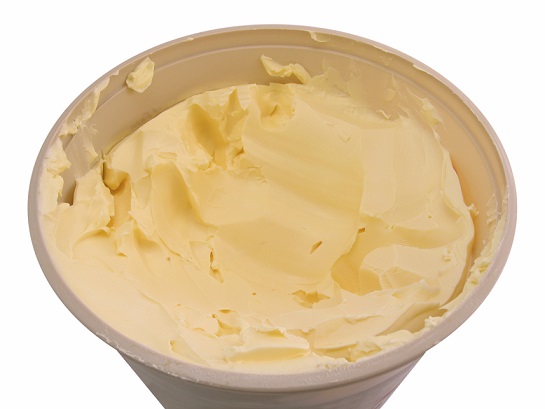 As we discussed earlier, trans-fats are absolutely everywhere. They were first invented about 100 years ago, and the first product containing them was the spread called Crisco. It was made from vegetable oils which were hardened using trans-fat, and contained roughly 50% trans-fat by weight. The parent company, Procter and Gamble, advertised it as being far healthier than the traditional fats like butter and lard.
As we discussed earlier, trans-fats are absolutely everywhere. They were first invented about 100 years ago, and the first product containing them was the spread called Crisco. It was made from vegetable oils which were hardened using trans-fat, and contained roughly 50% trans-fat by weight. The parent company, Procter and Gamble, advertised it as being far healthier than the traditional fats like butter and lard.
The public listened to the claims and began to use it, and it also came with a free cookbook that made the product even more popular. Procter and Gamble representatives even hung around on street corners handing people free donuts cooked in Crisco.
As intended, Crisco displaced lard as the predominant cooking oil. Flash forward a few decades, and scientists were coming out with studies suggesting that saturated fats were bad for your heart. They recommended switching to alternatives like vegetable oils and foods with trans-fats. At that time nobody knew how evil trans-fats were, so the trans-fat corporations quickly leapt in and promoted their hydrogenated products.
7 natural topical treatments which can massively reduce acne
By the 1980s, restaurants had switched from using butter or coconut oil to predominantly using trans-fat laden soybean oil or corn oil. The switch was massive and it took place in the wider food industry too. Food producers were beginning to understand the awesome potential of trans-fats for cost cutting.
That is the story of how trans-fats came to appear in every processed food imaginable. If you eat like a normal person then you will inevitably be getting a hefty dose of them. Some of the key sources of trans-fats are…
Margarine – margarine is the unofficial mascot of the trans-fat industry. The very nature of margarine is that of trans-fat, because it is basically a vegetable oil (which contain polyunsaturated fat) which has been hardened to become a solid spread. Modern day margarines are supposedly free from trans-fats, and some brands have indeed reduced them, but they are still there. A food can advertise itself as being “trans-fat free” if it contains below 0.5 grams of trans-fat.
Donuts – second only to margarine as the poster boy for trans-fats.
Ice cream – many highly processed ice creams or ice lollies are filled with trans-fats, to cut down on the amount of milk they have to use.
Popcorn – another notorious trans-fat bombshell. In fact, any food made from corn is an acne bombshell. I explain why in my eBook Annihilate Your Acne.
Crackers – again, the poor quality ones will be loaded with trans-fat.
Cakes, biscuits, and low grade chocolate– not guaranteed to contain trans-fats but highly likely to.
Commercial pizzas – a downmarket pizza crust is typically loaded with trans-fats, particularly those from takeaways. The same applies to pies and their fatty crusts. If you love pizza, then rest assured that the higher quality ones (like from Italian restaurants) will not contain trans-fats. Look for a pizza that contains olive oil like all great pizzas should.
Most fast food – chicken nuggets, fries, and many more are fried in trans-fat laden oils. Nobody goes to a fast food restaurant for their health so the producers have no qualms with filling the food full of acne-causing substances.
The reality is that any processed food with solid fat is a candidate. The ultimate solution is not to analyse every single food you buy, wasting time searching for trans-fats, but instead to simply eat less processed food. Trans-fats are only found in processed foods; a piece of raw steak won’t contain hydrogenated oils, a glass of fresh milk won’t either. Artificial trans-fats don’t appear anywhere in nature. By avoiding processed foods you can ruthlessly cut out all of these killer fats.
If you do eat processed foods then check the labels for trans-fats, hydrogenated fat, partially hydrogenated fat, or any similar ingredient. Also, I recommend that you any avoid foods with a “no-trans-fat” label. If a food has to display this, it’s obviously the kind of food that would probably contain trans-fats in the first place…
…and if it is, it probably DOES contain trans-fats. Any processed food can display “zero trans-fats” as long as the quantity is below 0.5 grams. That’s easily enough to cause harm.
Do not fear natural trans-fats
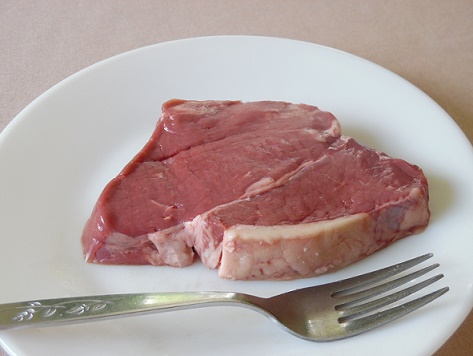 Trans-fats are only found in nature in the form of conjugated linoleic acid. The stomachs of ruminant animals like cows and lamb produce this fat naturally, but unlike artificial hydrogenated fats, conjugated linoleic acid is very healthy. It’s been linked to increased amounts of healthy gut bacteria, lowered inflammation in the body, and protection against heart disease.
Trans-fats are only found in nature in the form of conjugated linoleic acid. The stomachs of ruminant animals like cows and lamb produce this fat naturally, but unlike artificial hydrogenated fats, conjugated linoleic acid is very healthy. It’s been linked to increased amounts of healthy gut bacteria, lowered inflammation in the body, and protection against heart disease.
You do NOT need to worry about natural trans-fats. They may technically be a trans-fat but they are still structured somewhat differently to a tub of margarine. In terms of their health effects, they are polar opposites.
You can find conjugated linoleic acid in beef, lamb, and cow’s dairy and sheep’s dairy. Therefore if you are buying some meat, you read the label and you are shocked to see that there’s trans-fat in it, don’t worry. The same applies to dairy products.
It could of course have added trans-fat, which is bad, but as long as the product is pure and there are no additives, then the trans-fat will be 100% natural and safe.
Conclusion
If you have any acne at all, then avoid trans-fats at all costs! Trans-fats are extremely bad for you and to keep inflammation down, you must eat as few as possible.
The point about trans-fats is that they were not designed with any consideration for your health, they were only designed to make production a lot cheaper.
They are so dodgy for your body that governments are now banning them; the American FDA is considering it after a big review of the evidence. In 2013 the FDA decided that trans-fats are now “not fit for general consumption”. Even food companies are now getting cold feet and several giants, such as Burger King, have reduced the quantities of trans-fats in their oils recently.
This is excellent news and with all the consumer awareness about their dangerous effects, the trend should accelerate. In the meantime, you need to be vigilant as trans-fats can still be found everywhere. Once you remove them you will be able to achieve a good reduction in your chronic inflammation levels.
The good thing about trans-fats is that they are similar to sugar, in that anyone eating a normal Western diet will be eating tons of them. That sounds bad, but if you then take the effort to eliminate them, there’s an especially large scope for improving your skin.
Final message: say no to trans-fats. They are mutated versions of regular fats and no human is designed to eat them. If you want to be acne free and if you want any semblance of a healthy body, then you should avoid trans-fats as much as you possibly can.
NEXT: forget creams and moisturisers – discover the ultimate acne-clearing diet
Thanks for reading!